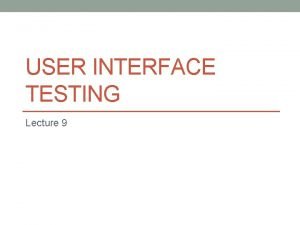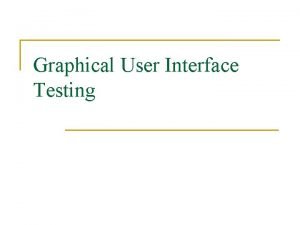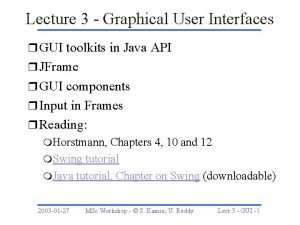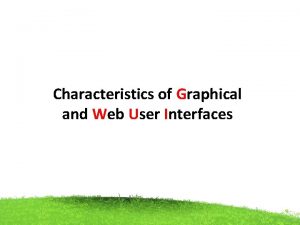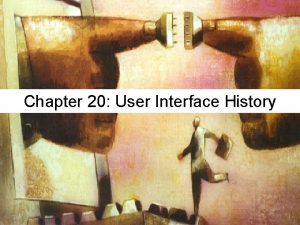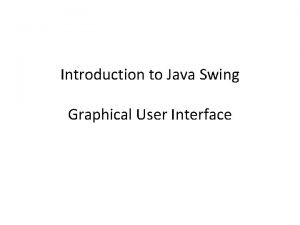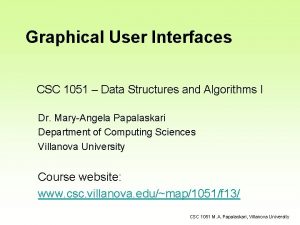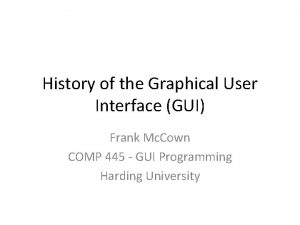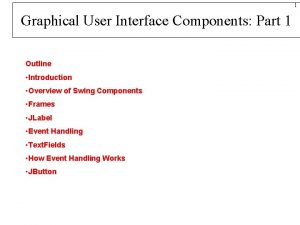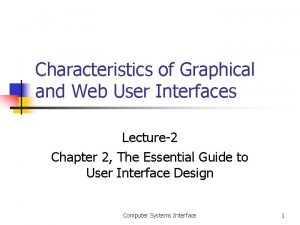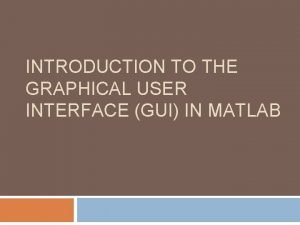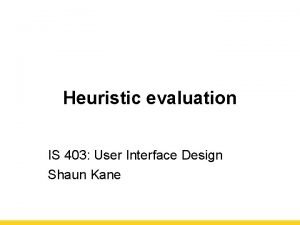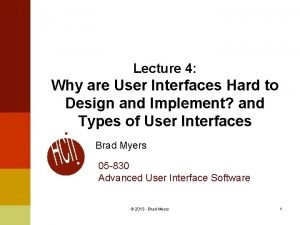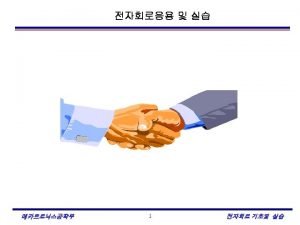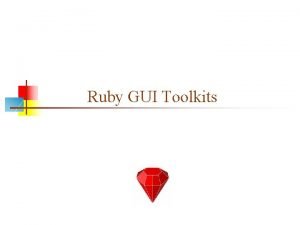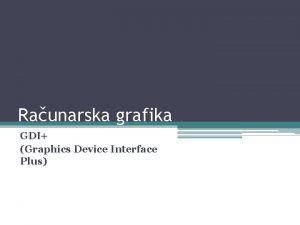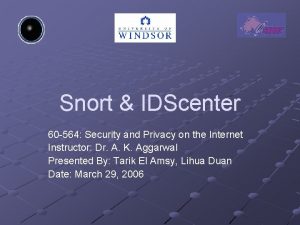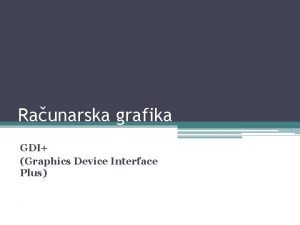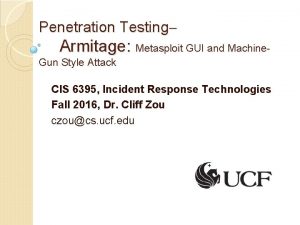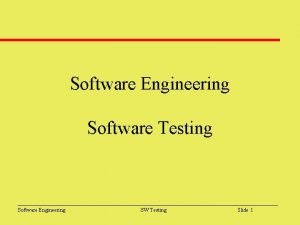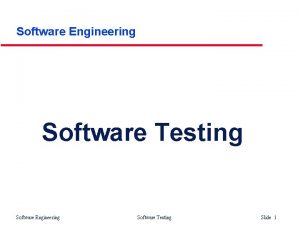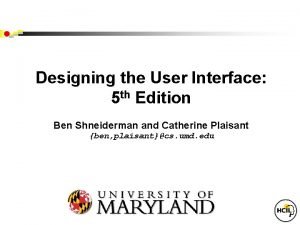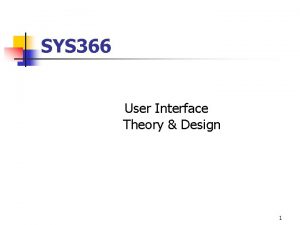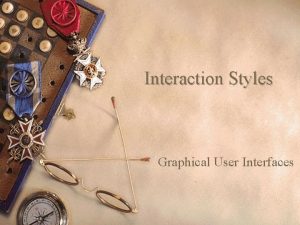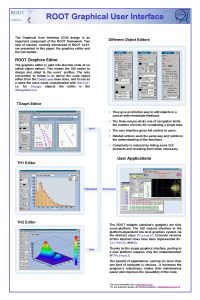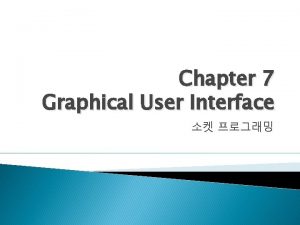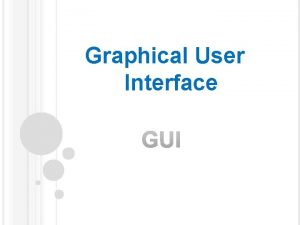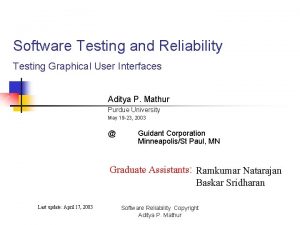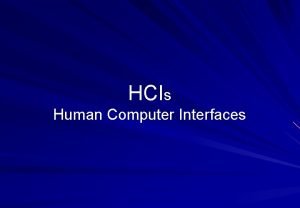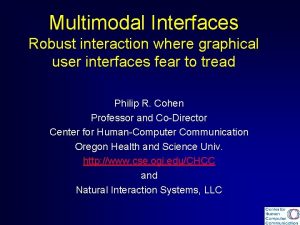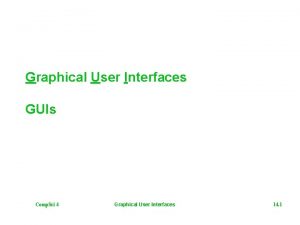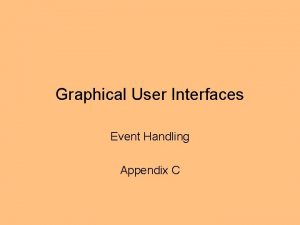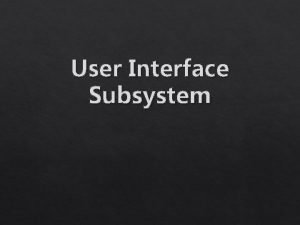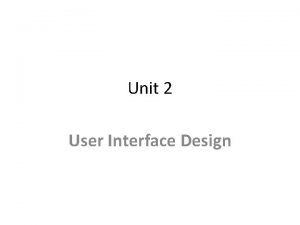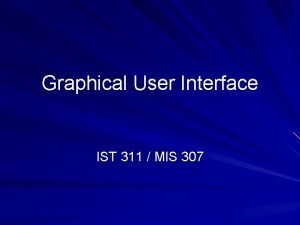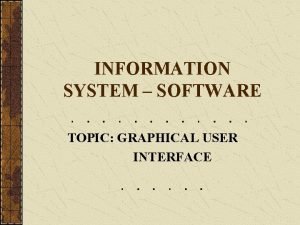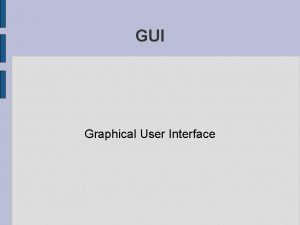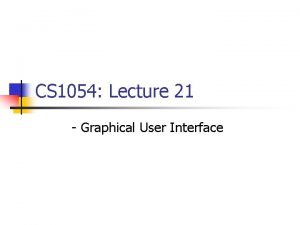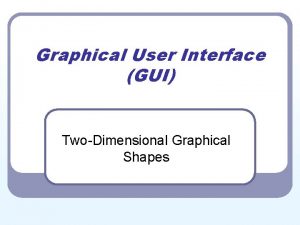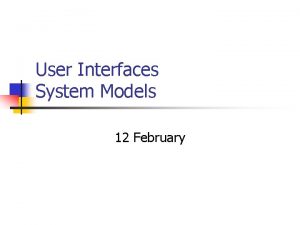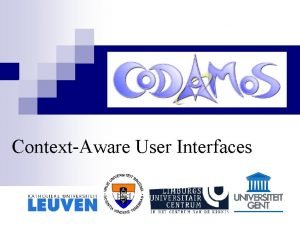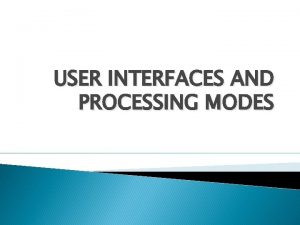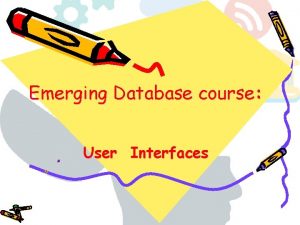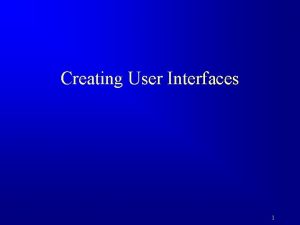Graphical User Interface Testing Graphical User Interfaces n





























- Slides: 29

Graphical User Interface Testing

Graphical User Interfaces n n n A graphical user interface (GUI) is composed of objects (buttons, menus) using metaphors familiar in real life. The software user interacts with the GUI objects by performing events that manipulate the GUI objects as one would do with the real objects. Events cause deterministic changes to the state of the software that may reflected by a change in the appearance of one or more GUI objects.

GUI Hierarchy n n n GUIs, by their vary nature, are hierarchical. This hierarchy is reflected in the grouping of events in windows, dialogs, and hierarchical menus that can be tested in isolation. Since there a large number of possible permutations of GUI events, this grouping of events decomposes GUI into manageable GUI components.

A Formal Definition of GUI n n n A GUI is a hierarchical, graphical front-end to a software that accepts as input usergenerated and system-generated events from a fixed set of events and produces deterministic graphical outputs. A GUI contains graphical objects and each object has a fixed set of properties. At any time during the execution of the GUI, these properties have discrete values, the set of which constitutes the state of the GUI.

Modal Windows n n A modal window is a GUI window that once invoked, monopolizes the GUI interaction, restricting the focus of the user to a specific range of events within the window, until the window is explicitly terminated. The language selection window in MS Word is an example of a modal window.

Modeless Windows n n Other windows in the GUI are called modeless windows that do not restrict the user’s focus; they merely expand the set of GUI events available to the user. In the MS Word, performing the event Replace opens a modeless window entitled Replace.

GUI Components n n At all times during interaction with the GUI, the user interacts with events within a modal dialog. This modal dialog consists of a modal window X and a set of modeless windows that have been invoked, either directly or indirectly by X. The modal dialog remains in place until X is explicitly terminated. Intuitively, the events within the modal dialog form a GUI component.

A Formal Definition of GUI Components n n A GUI component C is an ordered pair (RF, UF), where RF represents a modal window in terms of its events and UF is a set whose elements represent modeless windows also in terms of their events. Each element of UF is invoked either by an event in UF or RF. An example of a GUI component is the File. Open modal window (and its associated modeless windows) found in most of today’s software.

Event Interleaving n By definition, events within a component do not interleave with events in other components without the components being explicitly invoked or terminated.

Classification of GUI Events n n n Restricted–focus events. Unrestricted–focus events. Termination events. Menu-open events. System-interaction events.

Restricted-Focus Events n n Restricted–focus events open modal windows. The Set Language event in MS Word is an example.

Unrestricted–Focus Events n n n Unrestricted–focus events open modeless windows. The Replace event in MS Word is an example. Modeless windows also need to be explicitly terminated.

Termination Events n n Termination events close modal windows. Common examples include the Ok and Cancel events.

Menu-Open Events n n Menu-open events are used to open menus. They expand the set of events available to the user. Menu-open events do not interact with the underlying software. Common examples include the File and Edit events.

System-Interaction Events n n System-interaction events interact with the underlying software to perform some action. Common examples include the Copy event used for copying objects to the clipboard.

An Example: MS Word. Pad Component Menu System Restricted Unrestricted Termination Sum Name Open Interaction Focus Main File. Open File. Save Print Properties Page. Setup Format. Font 7 0 0 0 27 8 8 9 11 8 7 19 0 0 1 0 2 0 0 0 1 2 2 2 56 10 10 12 13 11 9 Sum 7 78 21 2 13 121

Event-Flow Graphs n n n An event-flow graph for a GUI component C is a 4 -tuple <V, E, B, I> where: V is a set of vertices representing all the events in the components. E V V is a set of directed edges between vertices. (vx, vy) E if vx immediately follows vy. B V is the set of events that are available when C is first invoked. I V is the set of restricted-focus events.

An Example: MS Word. Pad Help File Edit Open About Save Cut Copy To File, Edit and Help Paste Contents

Integration Trees n n n An integration tree is a 3 -tuple <N, R, B>, where: N is the set of components in the GUI. R N is a designated component called the Main component. We say that a component Cx invokes component Cy if Cx contains a restricted-focus event ex that invokes Cy. B N N is the set of directed edges showing the invoking relation between components.

An Example: MS Word. Pad Main Filenew File. Save Format. Font File. Open Page. Setup Print View. Options Properties

Testing Coverage Criteria n n Intra-component coverage Inter-component coverage

Intra-Component Coverage Criteria n n n Event coverage: each event (or vertex) in the component is performed at least once. Event-interaction coverage: each edge (vx, vy) in the component is performed at least once. Length-n event-sequence coverage: each event-sequence of length n is performed at least once.

Inter-Component Coverage Criteria n n n Invocation coverage: each restricted-focus event in the GUI is performed at least once. Invocation-termination coverage: each length 2 event sequence (ei, ej) in the GUI is performed at least once, where ei invokes component Cx and ej terminates component Cx. Intercomponent length-n event-sequence coverage: each event-sequence of length n that starts with an event in one component and ends with an event in another component is performed at least once.

Testing Coverage Criteria Hierarchy length-n event-sequence intercomponent length-n event-sequence event-interaction invocation-termination event invocation

Total Number of Event Sequences Component Name Main File. Open File. Save Print Properties Page. Setup Format. Font Print+Properties Main+File. Open Main+File. Save Main+Page. Setup Main+Format. Font Main+Print+Properties Event-Sequence Length 1’ 2’ 1 2 3 4 5 6 56 791 14354 255720 4490626 78385288 10 80 640 5120 40960 327680 12 108 972 8748 78732 708588 13 143 1573 17303 190333 2093663 11 88 704 5632 45056 360448 9 63 441 3087 21609 151263 1 2 13 260 3913 52520 663013 1 2 10 100 1180 17160 278760 1 2 11 110 1298 18876 306636 1 2 9 81 909 13311 220509 12 145 1930 28987 466578

GUI Testing Tools: GUITAR n n n GUITAR is a GUI Testing Framework that presents a unified solution to the GUI testing problem. Our emphasis has been on developing new event-based tools and techniques for various phases of GUI testing. http: //www. cs. umd. edu/~atif/GUITARWeb/

GUI Testing Tools: Abbot n n Abbot helps you test your Java UI. It comprises Abbot, which lets you programmatically drive UI components, and Costello (built on Abbot) which allows you to easily launch, explore and control an application. The framework may be used with both scripts and compiled code. http: //abbot. sourceforge. net/doc/overview. sht ml

GUI Testing Tools: JFCUnit n n n An extension to the JUnit framework that enables you to execute unit tests against code that presents a Swing GUI based interface. Recording and playback to/from XML allows novice GUI developers to generate and execute tests. https: //sourceforge. net/projects/jfcunit/

GUI Testing Tools: UISpec 4 J n n UISpec 4 J is an Open Source functional and/or unit testing library for Swing-based Java applications, built on top of the JUnit test harness. http: //www. uispec 4 j. org/index. html
 Graphical user interface testing
Graphical user interface testing Graphical user interface testing tools
Graphical user interface testing tools Programming graphical user interfaces in r
Programming graphical user interfaces in r Characteristics of graphical user interface
Characteristics of graphical user interface Idioms
Idioms Java graphical user interface
Java graphical user interface Graphical user interface in data structures
Graphical user interface in data structures Guidelines for data entry screen design
Guidelines for data entry screen design History of gui in java
History of gui in java Components of graphical user interface
Components of graphical user interface Principles of user interface design
Principles of user interface design User interface characteristics
User interface characteristics Web based interface
Web based interface Introduction of gui
Introduction of gui Heuristic evaluation of user interfaces
Heuristic evaluation of user interfaces Why are user interfaces hard to implement
Why are user interfaces hard to implement User interfaces design dc
User interfaces design dc Ruby gui programming
Ruby gui programming Grafika bmp
Grafika bmp Snort front end
Snort front end Graphical device interface with c
Graphical device interface with c Metasploit hail mary
Metasploit hail mary An interface
An interface What is interface in java
What is interface in java Fluidity in hci
Fluidity in hci Office interface vs industrial interface
Office interface vs industrial interface Types of testing in software engineering
Types of testing in software engineering Software testing
Software testing Ben shneiderman designing the user interface
Ben shneiderman designing the user interface User interface theory
User interface theory
